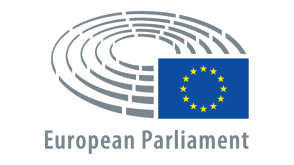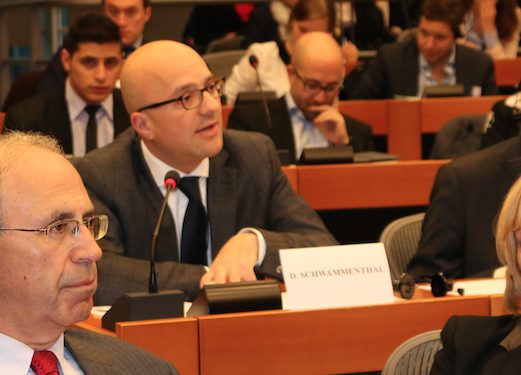Event
Wednesday, December 03, 2014 9:30 to 13:00
40th European Parliament – Knesset Inter-Parliamentary Meeting
On 3 December 2014, TAI Director Daniel Schwammenthal followed an invitation by the Chair of the European Parliament’s Delegation for Relations with Israel, MEP Fulvio Martusciello, to speak at the 40th EP-Knesset Interparliamentary Meeting.
Daniel briefed Members of the European Parliament and visiting Members of Knesset on the Iranian regime’s nuclear program and its implications for the security of Israel and the world at large. The talk came at the heels of a 7-month extension of the negotiations between Iran and the E3+3.
Remarks: TAI Director Daniel Schwammenthal on Iran at 40th European Parliament - Knesset Interparliamentary Meeting
On 3 December 2014, TAI Director Daniel Schwammenthal followed an invitation by the Chair of the European Parliament's Delegation for Relations with Israel to speak at the 40th EP-Knesset Interparliamentary Meeting. Daniel briefed Members of the European Parliament and visiting Members of Knesset on the Iranian regime's nuclear program and its implications for the security of Israel and the world at large. The talk came shortly after the negotiations between Iran and the E3+3 were extended for another seven months on 24 November 2014.
"Israel’s Security Threats – Iranian Nuclear Program"
by Daniel Schwammenthal, Director, AJC Transatlantic Institute
Before discussing the latest round of nuclear negotiations, it is unfortunately necessary to dispel some of the misconceptions about Iran currently gaining traction. We need to be clear-eyed about the nature of the Iranian regime to be able to realistically assess the chances for a comprehensive deal and to fully appreciate what's at stake if we fail to prevent Tehran from going nuclear.
One such misconception suggests that a "grand bargain" could be had, which could facilitate cooperation with the West, particularly on combating ISIS. The idea that you have to bribe the Iranian regime, possibly with nuclear concessions, to get them to fight their mortal enemies is, well, absurd. Iran is already fighting ISIS because it is in its own very interests. What's more, we must not overlook that Iran is just as dangerous if not more so than ISIS. As a regional, nuclear power threshold state, Tehran is leading a radical Islamist alliance that includes some very powerful proxies, such as Hezbollah, Iran has topped for years the US State Departments list of state sponsors of terrorism, it has armed and trained insurgents and terrorists in Iraq and Afghanistan, causing the deaths of numerous allied, including European soldiers. Tehran is also directly involved in terror attacks around the world, from Saudi Arabia to Argentina and recently, through its proxy Hezbollah, also here in Europe. Its forces continue to assist Assad in butchering his own people and Tehran is arming Hamas and Islamic Jihad in Gaza.
Nothing even hints at a so-called strategic shift in Tehran. Another fallacy is to dismiss Tehran's repeated threats against Israel as mere rhetoric, part of typical Middle Eastern posturing. It overlooks the deep religious-ideological convictions which inform not only the regimes positions Israel but the West in general as well as toward homosexuals, women or apostates. Those hangings and stonings are quite real and, according to the UN, are getting worse under President Rouhani. It is quite baffling to me why in Europe of all places, with its recent history of totalitarianism, genocide and ethnic cleansing, and given the numerous examples of genocide and mass slaughter elsewhere, so many refuse to even contemplate that the mullahs may actually mean what they saw about Israel. Gregory Stanton, one of the worlds most renowned genocide scholars, is less complacent. “One of the best predictors of genocide is incitement to genocide and I believe that is exactly what Iran is doing today.” Ignoring these early signs, he said, “dismissing them as diabolical rhetoric or as a tactic meant to advance a different goal, is to enable the perpetrators." This brings me straight to another misconception, namely that if all fails, Iran could be easily contained, as the US did with the Soviet Union. It dangerously overlooks the strategic consequence of a nuclear-armed Iran. Even if deterred from using it, Iran would be able to leverage mere possession of the bomb to advance its destabilizing policies. Believing, probably rightly, that its nuclear umbrella makes it untouchable, it could embolden Hamas and Hezbollah to escalate their military confrontation with Israel, thus ending all hope for a two state solution. And it could use its nuclear status to bring the Gulf region, through threats and proxies or direct military intervention, under its control. But the Cold War analogy fails on a more fundamental level. The fact that we survived the previous nuclear stand-off is hardly evidence that it was bound to succeed. On more than one occasion, the struggle with Communism, the threat of mutually that it was bound to succeed on more than one occasion did not prevent the two sides from stepping to the brink, most famously during the Cuban Missile crisis. Moreover, to the extent that MAD (Mutually Assured Destruction) worked, it was thanks to certain parameters missing in any future standoff with Tehran. For example, during the Cold War the two sides had clear channels of communication - remember those famous red telephones? - and shared a modicum of trust and knowledge about their opponents. Nothing of this sort exists between the US. and Israel on one side and Iran on the other. There are no diplomatic relations.
Far from not having “red telephones," you cannot even make regular phone calls between Israel and Iran. The absence of such direct contacts raises the chance of either side misreading its opponent’s intentions. The idea of trying to contain a nuclear Iran also overlooks the fact that Tehran's acquisition of the bomb would kill the Non-Proliferation Treaty and trigger a nuclear arms race in the region. Countries such as Saudi Arabia, United Arab Emirates or Turkey will not rely on Western promises to protect them from a nuclear Iran after the same West reneged on its promise to prevent a nuclear Iran in the first place. With so many nuclear actors, any of the regions numerous conflicts could suddenly become the trigger for a nuclear exchange. Even if the Iranians and all other future nuclear powers in the region accepted the basic logic of deterrence, the risks of nuclear war by misinterpretation, technical error or miscalculation could prove unmanageable.
So where do we stand now?
On November 24 last year, the E3-3 agreed on the joint plan of action, which froze and rolled back some aspects of Iran's nuclear program in return for limited sanctions relief. But those Iranian concessions are all reversible. And the agreement only tackled enrichment but failed to address the other two elements of Iran's nuclear program, namely ballistic missiles, which are necessary to deliver a nuclear payload, and weaponization research, also referred to as the “possible military dimensions" of Iran's program. While missiles won't be addressed at all, the question of weaponization has been left with the IAEA, which reported zero progress on this issue. Iran, for example, continues to deny inspectors access to the Parchin military site, where the IAEA suspects that Iran has built a blast chamber for testing nuclear-weapons components. Satellite images suggest frantic cleaning up operations to cover any tracks of their nuclear experiments. The interim deal also outlined the broad parameters for negotiating a comprehensive solution, some of which caused concerns not only in Israel but in the wider region and among Western security experts because they were seen as significant diplomatic victories for Iran. The E33 basically renounced the requirement - enshrined in multiple UN Security Council resolutions - that Iran suspend enrichment, reprocessing, and heavy waterrelated activities. Tehran gained de-facto international recognition of a right to enrich uranium. It also secured legitimacy for its facilities at Natanz and Arak, which had been constructed secretly in violation of Iran's Nonproliferation Treaty obligations. Finally, the interim agreement established that any comprehensive deal would have a time limit, irrespective of the nature and behavior of the Iranian regime at the end of the agreements expiration date. Despite these favorable concessions to Tehran, Iran could not agree on a deal and negotiations had to be extended last month for a second time until July.
The major disagreements surrounded the following issues:
1. Iran's enrichment capacity
The US. and its Western allies want to minimize the number and type of centrifuges that Iran will be allowed to keep, with a view to extending the “breakout" timeline, i.e., the amount of time it would take Iran to enrich a sufficient quantity of weapons grade uranium to build a nuclear weapon. The current estimated “breakout" time is two to three months, the West wants to extend it to at least a year. Many experts, including Oli Heinonen, the former Deputy Director of the IAEA, believe a one year period is insufficient to allow effective Western countermeasure. Despite this, Iran insists on keeping a significant portion of the more than 19,000 centrifuges it has installed.
2. The schedule of removing the sanctions
Iran wants the sanctions to be lifted swiftly, while the E3+3 are willing to suspend them only progressively, alongside, and conditional upon, Iran's fulfilment of its obligations under the deal.
3. The duration of the deal
The E3+3 demand that the deal should last up to 20 years. The Iranians insist on a much shorter period.
Where do we go from here?
An additional limited extension of the negotiations was likely the “least bad” of current political options. Having said this, the interim agreement, which “freezes" certain aspects of Iran's nuclear program, should not be further extended, lest it become permanent, thus confirming Iran's status as a nuclear threshold state. Any comprehensive agreement must, as US Secretary Kerry said in his remarks in Vienna last month, “close off all of the pathways for Iran to get fissile material for a nuclear weapon." As such, a deal must include a clear and verifiable commitment by Iran to renounce enrichment-related capacity, dismantle the Arak heavy water reactor, cooperate with the IAEA, including full disclosure of its nuclear programs military dimensions, and enter into compliance with UN Security Council resolutions.
How do we achieve this?
In a way, the answer is rather straightforward. The West simply needs to persuade Tehran that the damages resulting from a failure to reach an agreement on the West’s red lines outweighs the perceived benefits from continued resistance. The only way to try to a achieve such an outcome for the EU and the US to warn Iran that the concessions in the interim agreement expire with that agreement, and that no substantive enhancements to the E3+3 offer will be forthcoming. Amid a readiness to use force as a last resort, the West must be further ready to threaten and impose additional sanctions if talks do not succeed by a certain date, after all, it was the previous round of sanctions that brought Tehran to the negotiating table. Also, improve enforcement of existing sanctions, and agree in advance how to effectively penalize Iranian cheating - if a deal is reached.
Date and time
Date and time
08:30 - 12:00 WET
09:30 - 13:00 CET
10:30 - 14:00 EET
Location
Partner

